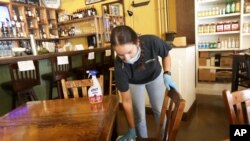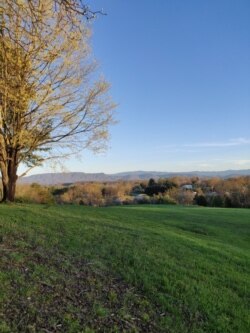As officials around the globe weigh easing lockdown restrictions caused by the coronavirus pandemic, they are faced with finding a balance between personal safety and personal freedom.
That is the case in the southeastern U.S. state of Tennessee, which ranks about 20th among the 50 U.S. states in the number of confirmed cases of coronavirus and about 30th in the number of deaths.
Tennessee’s governor put a stay-at-home order in place in mid-March. But the order expired on April 30. It also was one of the first states to see protests aimed at easing stay-at-home restrictions, which would allow for the reopening of businesses.
Personal stories
East Tennessee resident Andy Rines' family reunion was canceled because of the restrictions. He calls that loss "an unfortunate consequence of a mass overreaction."
Linda Wilder, who lives in the same part of the state, has season tickets to Dollywood, a nearby amusement park. “Boy, did I pick a bad year for that,” she said, ruefully. Even when the park opens back up, she isn't sure when she'll feel comfortable going.
Last week Tennessee relaxed more social-distancing restrictions, allowing restaurants and retail stores to lift capacity restrictions and enabling attractions and large venues to reopen with social-distancing restrictions in place. As of Friday, all 50 U.S. states had begun easing some restrictions.
That’s what worries Wilder, who lives about a half-hour’s drive from a popular tourist destination, the Great Smoky Mountains National Park. Wilder’s husband also has a compromised immune system, which puts him among people at higher risk of contracting the coronavirus, according to health officials.
However, teacher Rines thinks the lockdown was unnecessary, as the county, and the state, are not hotbeds of coronavirus activity.
Most of Tennessee’s coronavirus infections have been in the urban centers in each third of the state: Memphis in the west, Nashville in the middle, and Knoxville in the east. Mountainous eastern Tennessee has fewer cases than the more heavily populated middle and western portions of the state.
Overall, Tennessee has recorded more than 20,000 confirmed cases of COVID-19, the disease caused by the coronavirus, and 336 deaths, according to Tennessee state records.
Worldwide, there are more than 5.4 million confirmed cases of coronavirus and 345,000 deaths, according to Johns Hopkins University statistics. The U.S. continues to lead the world in confirmed cases, with more than 1.6 million, and deaths, at more than 97,700.
Tourism affected
The restrictions have had a particularly harsh effect on Sevier County, home to many of the tourist attractions that surround the Tennessee side of the Great Smoky Mountains National Park. It’s the most-visited national park in the nation.
The U.S. Bureau of Labor Statistics said about half of Sevier County’s private sector workers have jobs in tourism or leisure, and the shutdown has left the streets of its tourist towns, lined with hotels, restaurants, shops, go-kart tracks and miniature golf courses, close to empty.
Over the past nine weeks, 38.6 million jobless workers have filed for cash benefits, almost one of every four employees in the U.S. labor force of more than 164 million. In April, the official U.S. unemployment rate was 14.7%, but key Trump administration economic officials say it likely is higher and could approach 25% in the coming weeks.
In April, the jobless rate in Tennessee also was 14.7%, according to a Tennessee Department of Labor and Workforce Development report released Thursday.
When the Great Smoky Mountains National Park partially reopened May 9, the weather was cool but bright and sunny, and the visitors flooded in.
Local news reports said parking lots were full. They also reported that not all visitors were wearing masks and that many were not staying 2 meters from each other or sticking to the areas of the park that had officially reopened.
Worried about reopening
Wilder is worried, both about the relaxation of the rules and the influx of tourists. She lives near the park, in the small lakeside town of Dandridge, in Jefferson County, Tennessee.
Wilder and her husband, whose immune system is compromised due to Crohn’s disease, have continued working throughout the shutdown, as have her two grown sons. Jefferson County, a collection of small communities with just under 55,000 residents, has recorded only 27 confirmed cases of COVID-19 and no deaths blamed on the virus.
But her youngest son delivers soft drinks to grocery stores in Sevier County’s two big tourist towns, Pigeon Forge and Gatlinburg.
“He’s in multiple grocery stores every day, exposed to everything,” she said. He has a history of asthma, and she worries about his lungs.
She said in a recent interview that she worries that people aren’t taking the danger of the pandemic seriously enough. “So many people I’ve talked to, they’re so flippant about it,” she said.
Wilder works in a lab in Knoxville, home to about 188,000 residents and the University of Tennessee, which enrolls nearly 30,000 students each year. So far, the Johns Hopkins Coronavirus Resource Center has counted only 321 cases of COVID-19 in Knox County, of which Knoxville is the county seat, and five deaths.
Wilder has been working at home as much as possible, but the day after Tennessee’s Safer at Home Order expired April 30, Wilder had to make the 20-mile drive to work.
She had grown used to the light traffic on the interstate highway during the stay-at-home orders, but by the time she left work on May 1, she said, “It was just like it was right before everything shut down. The interstate was just packed. Even in Dandridge, there were people everywhere.”
She understands the need to get out of the house. While working from home has been a pleasant experience, Wilder said she really misses her church of 21 years and her work in the nursery there.
And she and her husband have not seen his 77-year-old mother, who lives in Knox County, since March. Wilder said her mother-in-law has been following the rules and staying home.
“She has not left the house except to pick up prescriptions at the drive-through,” Wilder said, noting that she stays in touch with her in-laws and other family members via smartphone apps.
But summer is coming, and with it, the sports and recreational activities that draw people to the area in large numbers.
“You know, the ball games, all the children getting together, having practices all the time,” she said. “And UT football games? There’s no way you can social-distance (keep 2 meters apart) at things like that.”
Supports reopening
On the other hand, Rines is eager to get things back to normal. He teaches English and coaches basketball in nearby Sevier County.
He grieves for the experiences his students, especially his seniors, have missed out on as they completed their last year of high school in isolation.
“One senior said, ‘I had no idea my last day of high school would be on a Friday in March,’” Rines said recently in an email. “As teachers, we never got to say goodbye to students we have worked with, shared with, laughed with, and cried with for four years.”
Rines said he doesn’t believe the shutdown orders were necessary. As of May 22, Sevier County had had only 69 confirmed cases of COVID-19 and two deaths.
“The shutdown may have minimized the spread of COVID-19 to some degree, but given that most patients display mild symptoms or no symptoms at all, its effectiveness was minimal at best,” Rines said of Sevier County.
The World Health Organization said about 1 in 5 people who develop COVID-19 will become seriously ill. Some 80 percent recover from the disease without going to the hospital.
But in an information sheet, the WHO noted that “anyone can catch COVID-19 and become seriously ill.”
Rines said that is a gamble worth taking.
“It is essential that we get back to work,” he said. “I’m looking forward to the things that serve as the fabric of our lives – sports, concerts, banquets, business travel, amusement parks, graduations, beaches. On a personal level, I’m looking forward to the high school basketball team getting to be together again. … I’m looking forward to going back to school in the fall and seeing my students, face to face.”
Does he have any fears for the future? “I have no fears for the future regarding the virus,” he said. “I never did.”










